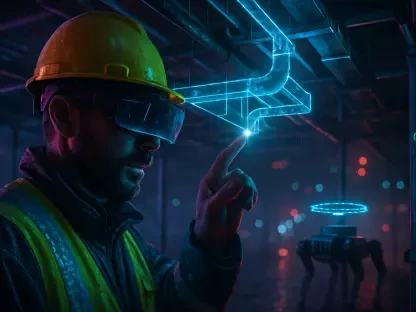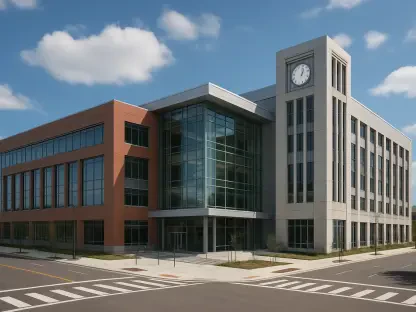The Architecture, Engineering, and Construction (AEC) sector is undergoing a significant transformation, spurred by the convergence of artificial intelligence (AI) and cutting-edge technology. This evolution is seen most prominently in the transition from 2D to 3D formats. Although Building Information Modeling (BIM) has positioned itself as a cornerstone in modern digital practices, traditional 2D drawings still hold immense value. The industry faces the ongoing challenge of harmonizing historical methods with progressive tools to foster one coherent and integrated system. Through the lens of this dynamic interchange, stakeholders are now exploring how AI can effectively bridge these dimensions, enhancing both heritage and efficiency in the process.
The Transition from Traditional to Modern Methods
The Enduring Presence and Importance of 2D
In the realm of AEC, the enduring relevance of 2D illustrations reflects their entrenched role in documentation and design processes. Despite the growing traction of 3D applications like BIM, the simplicity and accessibility of two-dimensional mediums have preserved their relevance. Architectural design still frequently commences with 2D sketches, even as more advanced digital renditions become pivotal later in the project lifecycle. This enduring utility is due to several factors, such as ease of interpretation, lower cost of creation, and a long-standing familiarity among designers and architects.
Yet, as technology escalates, so does the tendency to harness algorithms and machine learning, dramatically reducing the tedious efforts associated with the manual conversion of 2D designs into 3D models. Automated procedures have emerged, where traditional sketches can be digitally transformed with precision, component analysis, and speed previously deemed impractical. While some purists argue that this transition might lose the artistic aspect inherent to manual crafting, many professionals also see it as an enabler of increased productivity and innovation.
The Rise of 3D BIM and Its Analytic Capabilities
With the widespread adoption of 3D BIM, the architecture field has witnessed unparalleled improvements in project visualization and collaboration. BIM not only simulates physical structures but bolsters design foresight through analytical capabilities, anticipating potential structural challenges before actual construction happens. This shift from static images to interactive models enhances communication channels among team members, cross-functional areas, and clients. Decisions can be made earlier and more effectively by visualizing potential design flaws or mechanical-system clashes, reducing delays, reworks, and associated costs.
The adaptability of BIM has also steered the industry toward data-enriched environments like digital twins and smart buildings. These systems rely on continual syncing of on-site conditions and dynamic modeling for immediate feedback and real-time updates. With areas such as sustainability and energy performance increasingly at the forefront, BIM-infused processes contribute to green initiatives and long-term operational savings. As professionals recognize its multifaceted use, BIM is becoming more than just a visualization tool—it is also an all-encompassing resource that harmonizes stakeholders’ knowledge to ensure streamlined execution.
AI and Automation: Reshaping Design Processes
Innovations in Automated Drawing Creation
Artificial intelligence and machine learning are swiftly shifting the landscape of drawing processes from the manual realm to an era of sophisticated automation. By leveraging AI, intricate designs are more effortlessly transformed from rudimentary 2D sketches into enriched 3D models. Companies at the forefront of this technological shift, such as WiseBIM, Plans2BIM, and others, demonstrate how automated platforms can reduce the labor-intensive nature of this process, bridging the gap between initial concepts and fully-fledged digital models.
Utilizing expansive databases and pattern recognition algorithms, AI tools are capable of understanding and generating representations that maintain the integrity of the original designs while enhancing them with greater detail. This automation reduces time and cost expenditures and presents an opportunity for those unfamiliar with specialized software to engage more fully in the design process. The democratization of design tools propels a new wave of inclusivity within professional and amateur circles, modernizing the approach to structural documentation and participation.
Converting Legacy Drawings to Digital Models
The drive to digitize older, paper-based records continues at an accelerated pace, especially as younger generations of architects and engineers seek sustainable and collaboratively versatile methods. Converting archival documents into digital models forms the bedrock of many modernization projects, enabling facilities management to engage with assets more cohesively and sustainably.
Harnessing AI’s ability to process vast quantities of historical records ensures that the intricate detailing in legacy drawings finds expression in digital formats suitable for 3D viewing and manipulation. Notably, model generation from these records underpins efforts to rejuvenate outdated infrastructures, reintroducing them in digitized and enhanced constructs. Complexities surrounding older buildings requiring environmental or situational adaptation are more efficiently tackled through this vector, demonstrating technology’s role as both conservator and innovator in preserving architectural history.
Strategic Impacts and Future Trends
Expansion of Digital Workflows in AEC
As AEC workflows modernize, a clear trend toward digital-first processes and models emerges, inherently tied to the push for automation. This new way of working prioritizes not only efficiency but sustainability—a concept embodied in the evolving smart city movements and green building certifications. By prioritizing digital solutions, industries aim to meet the demands of contemporary environmental standards and the need for sustainable urbanization.
Navigating this terrain requires an adept understanding of how AI and analytics intersect with technological platforms. Machine learning enables the inspection and correction of different facets of design inaccuracies in a fraction of the time previously allotted. These improvements not only refine finished products but also align them with industry standards, changing the landscape from one of static output to living intelligence-driven systems. The impact on operational efficiencies and strategy development is profound, pushing AEC stakeholders to review their conventional methodologies in achieving holistic outcomes.
The Importance of User-Friendly Interfaces
AI-driven tools, while revolutionary, must prioritize accessible user experiences to meet the needs of varied expertise levels among users. Providing intuitive interfaces in design suites liberates both seasoned and amateur architects from complex training requirements, allowing broader system adoption. Crucially, the ability to hybridize input—where AI augments rather than obscures design intention—equips professionals with agile functionalities suitable for fast-paced environments.
This democratization extends beyond creating assets, inviting users to participate, modify, and manipulate architectural projects with newfound flexibility and tailored guidance. Bridging traditional or hesitant education approaches with forward-thinking practices fosters a willingness to engage, creating a collaborative ecosystem where learning and innovation coexist. Ultimately, education, collaboration, and user empowerment continue to be instrumental in embedding AI into the AEC industry’s structural DNA, guiding the transition toward seamless integration across diverse digital landscapes.
Future Considerations and Sector Evolution
Capitalizing on New Market Potentials
Aligning architectural practices with next-generation technologies presents expansive market potentials. By harnessing AI’s full capabilities—from design conception to on-site application—companies can revolutionize interactions, fostering greater connectivity and interoperability. Bringing formerly siloed sectors into a unified approach changes how construction firms, regulatory bodies, and educational institutions operate, adapt, and anticipate future demands.
Regions with rich architectural history stand at a pivotal juncture where maintaining heritage and promoting innovation dovetail. With AI’s ability to accommodate different infrastructural standards, including legacy systems and large-scale modernization plans, businesses and municipalities alike find new ways to format foundational strategies and development initiatives. The prospects for bolstered efficiency, cost-effectiveness, and conceptual creativity remain immense, emphasizing the need for companies to invest in platforms and training that leverage this technology fully.
Preparing for an AI-Integrated Future
The Architecture, Engineering, and Construction (AEC) industry is experiencing a profound shift influenced by advanced technologies and the integration of artificial intelligence (AI). This transformation is especially noticeable in the movement from traditional 2D designs to expansive 3D models. Building Information Modeling (BIM) has emerged as a pivotal aspect in modern digital practices, offering detailed visualizations and simulations. However, despite these advances, 2D drawings remain crucial in many aspects due to their simplicity and ease of understanding. The challenge for the industry is to balance these historical techniques with innovative technologies to create a unified, seamless system.
This reconciliation process opens new avenues for stakeholders to ponder how AI might serve as a catalyst in merging these dimensions, fostering a harmonious blend of tradition and innovation. AI presents opportunities to enhance efficiency while respecting long-established practices. As architects, engineers, and construction professionals delve deeper into these possibilities, they can view AI as a crucial tool to aid in communication, planning, and execution, thus preserving the heritage yet paving the way for futuristic developments in the AEC sector. Through this dynamic interchange, the sector aims to enhance both traditional values and technological advancements, sparking a productive transformation.









